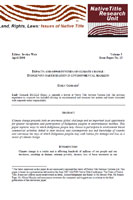Impacts and opportunities of climate change: Indigenous participation in environmental markets
Climate change presents both an enormous global challenge and an important local opportunity for greater recognition and participation of Indigenous peoples in environmental markets. This paper explores ways in which Indigenous people may choose to participate in environment based commercial activities linked to their historic and contemporary use and knowledge of country and canvasses the ways in which Indigenous peoples may seek redress for damage and loss as a result of climate change.
In March 2005 the Commonwealth Government released the report Climate change, risks and vulnerabilities: Promoting an efficient adaptation response in Australia. The opening paragraphs of the report note that there is little doubt that Australia will face some degree of climate change over the next 30 to 50 years, irrespective of efforts to reduce greenhouse gas emissions.
A growing body of data and scientific opinion demonstrates that global warming or 'climate change' is occurring as a result of human activities (anthropogenic emissions). Acknowledgement of climate change and the potential impacts and consequences of temperature rises has turned the world's attention to strategies for mitigation and adaptation. In Australia, to date there has been little space afforded for dialogue and collaboration with Indigenous Australians who face serious impacts and shifts as a result of climate change.
This paper discusses both the challenges and the opportunities emerging from a changing climate. In light of the rapid development of domestic and international law and policy in this area, this paper presents a conceptual discussion. It begins with an overview of climate change including global responses, Australia's response and the challenges facing Indigenous peoples. A discussion of opportunities that may arise from Native Title and land rights systems follows, including an overview of two case studies relevant to carbon abatement projects. Finally, this paper sets out what climate related litigation may look like for Indigenous peoples in Australia.
